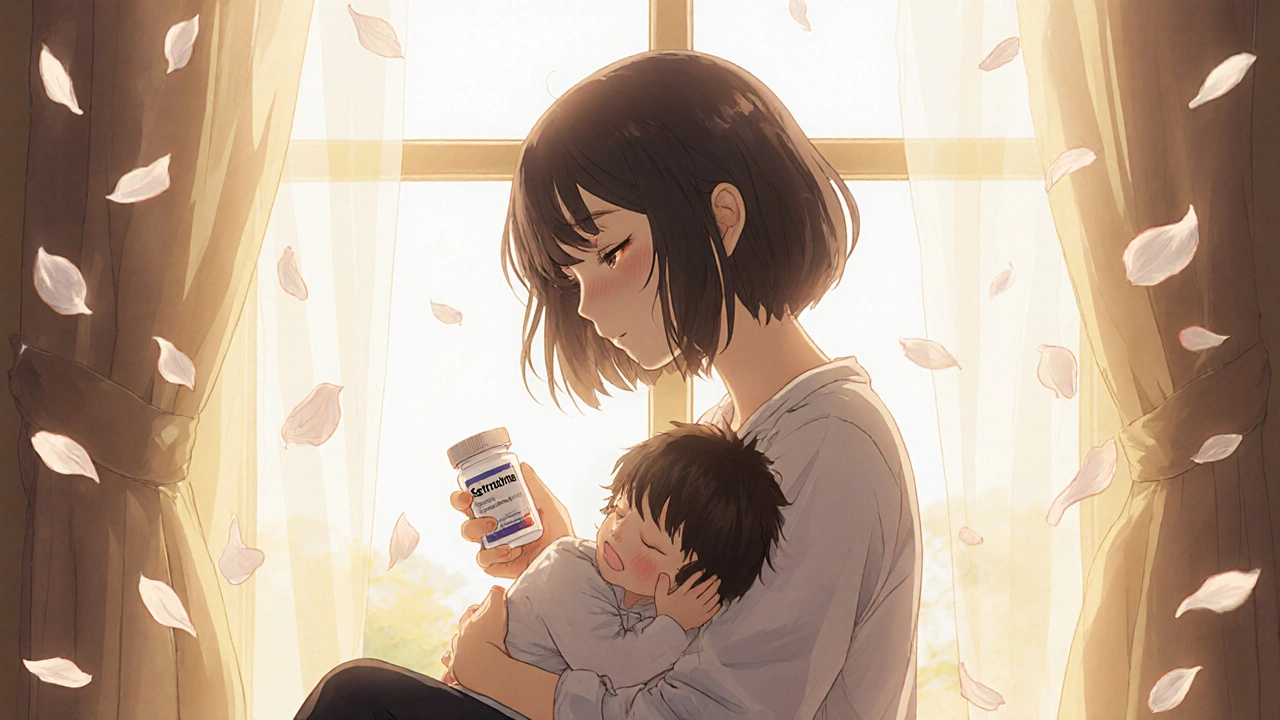
Breastfeeding Medication Safety Calculator
Medication Safety Calculator
Find the Relative Infant Dose (RID) for your antidepressant based on clinical evidence. RID shows the percentage of your dose that reaches your baby through breast milk.
Enter your medication and dose to see your baby's infant dose exposure
When a new mom feels overwhelmed, weepy, or disconnected from her baby, it’s easy to brush it off as the "baby blues." But if those feelings last more than two weeks, it could be postpartum depression (PPD). About 1 in 8 women experience PPD after giving birth, and left untreated, it can affect bonding, sleep, nutrition, and even the baby’s development. The good news? It’s treatable. The hard part? Choosing a medication that helps you without harming your baby-especially if you’re breastfeeding.
Why Antidepressants Are Often the Best Choice
Many moms worry that taking antidepressants while breastfeeding means poisoning their baby. But the truth is, untreated depression carries far greater risks. The American College of Obstetricians and Gynecologists (ACOG), the CDC, and the American Academy of Pediatrics all agree: the harm from depression-like poor feeding, missed doctor visits, or even neglect-is much more dangerous than the tiny amount of medication that passes into breast milk. A 2022 review of 27 studies involving over 1,800 mother-baby pairs found no significant health problems in infants whose mothers took sertraline while breastfeeding. In 92% of those cases, the baby’s blood levels of the drug were too low to measure. That’s not luck. It’s science.Which Antidepressants Are Safest During Breastfeeding?
Not all antidepressants are created equal when it comes to breastfeeding. The key metric doctors use is the Relative Infant Dose (RID)-how much of the mom’s dose actually reaches the baby through milk. Anything under 10% is generally considered safe.- Sertraline (Zoloft): The gold standard. Only 0.5% to 3.2% of the mom’s dose gets into breast milk. Most babies show no effects at all. It’s the first choice for most providers.
- Paroxetine (Paxil): Also low transfer (0.9%-8.6%). Works well for anxiety-heavy PPD. Some moms report drowsiness in babies at higher doses, but it’s rare.
- Citalopram (Celexa): Moderate transfer (3.5%-8.9%). Safe for most, but avoid doses over 40mg daily-higher amounts may affect the baby’s heart rhythm.
- Escitalopram (Lexapro): Similar to citalopram, but slightly lower transfer. Often used when citalopram doesn’t work.
Antidepressants to Avoid or Use With Caution
Some meds are riskier than others. Even small amounts can build up in a newborn’s system-especially if they’re under 2 months old, premature, or have health issues.- Fluoxetine (Prozac): High transfer (5.9%-15.2%) and stays in the body for weeks. Its active metabolite, norfluoxetine, can accumulate in babies. There are documented cases of irritability, poor feeding, and even sleep problems in infants exposed long-term.
- Doxepin: Linked to infant apnea and cyanosis (blue skin) at doses as low as 75mg daily. Avoid entirely while breastfeeding.
- Bupropion (Wellbutrin): May increase seizure risk in infants. Theoretical exposure is 6%-10%. Only consider if other options fail and you’re under close monitoring.
- Venlafaxine (Effexor): Transfer is low (1.4%-5.9%), but at doses over 150mg daily, babies have shown increased fussiness and sleep issues.
Newer Options: Zuranolone and What You Need to Know
In August 2023, the FDA approved zuranolone (Zurzuvae)-the first oral pill made specifically for postpartum depression. It works fast: half the women in trials saw major improvement in just 15 days. But here’s the catch: the original clinical trials required moms to stop breastfeeding. So official labeling says, "No data on human milk." That doesn’t mean it’s dangerous. LactMed, the NIH’s trusted drug database, estimates only 0.5%-1.5% of the mom’s dose gets into breast milk-lower than most SSRIs. Still, ACOG currently recommends pumping and dumping for one week after the last dose. Many experts believe this guidance will change soon. If you’re considering zuranolone, talk to your doctor about the latest data and whether pumping is truly necessary in your case.
How to Minimize Baby’s Exposure
Even with safe meds, you can reduce your baby’s exposure even further:- Take your dose right after breastfeeding. This gives your body time to clear the drug before the next feeding. For most SSRIs, peak milk levels happen 6-12 hours after taking the pill.
- Start low, go slow. Begin with the lowest effective dose. For sertraline, that’s often 25-50mg daily. You can increase later if needed.
- Watch your baby closely for the first 2-4 weeks. Look for signs like excessive sleepiness, trouble latching, unusual crying, or poor weight gain. Most issues are mild and go away with time or a small dose tweak.
- Don’t quit cold turkey. Stopping antidepressants suddenly can trigger withdrawal symptoms in you-and relapse rates jump threefold. Always taper under medical supervision.
What Moms Really Experience
Surveys and online forums give us real-world insight. A 2021 study of 347 breastfeeding moms with PPD found that 78% stayed on antidepressants. Of those, 86% said their babies showed no noticeable side effects. But 12% did notice changes:- 6.3% said their baby became more fussy
- 4.1% noticed sleep problems
- 1.6% had feeding difficulties
When to Call the Doctor
Most side effects are mild and temporary. But call your pediatrician or OB-GYN if your baby shows:- Extreme drowsiness (can’t wake up for feeds)
- Difficulty sucking or swallowing
- Blue lips or skin
- Unexplained vomiting or diarrhea
- Seizures or unusual twitching

Screening and Support Are Key
The American Academy of Pediatrics recommends screening for PPD at every well-baby visit-at 1, 2, 4, and 6 months. The tool they use? The Edinburgh Postnatal Depression Scale (EPDS). It’s a simple 10-question quiz. If your score is 13 or higher, you should be evaluated. And you’re not alone. Postpartum Support International (PSI) offers free peer support groups, and the InfantRisk Center runs a hotline (806-352-2519) staffed by pharmacists who specialize in breastfeeding and meds. They answer about 3,000 calls a month-many from moms just like you.What’s Coming Next
Research is moving fast. The B.R.I.D.G.E. study, tracking over 500 babies exposed to SSRIs through breast milk, will report long-term developmental outcomes by late 2024. Early data suggests no negative impact on motor skills or language development. And scientists are now studying how a baby’s genes affect how they process meds. One 2022 study found infants with a specific gene variant (CYP2D6 poor metabolizer) had over three times the blood levels of venlafaxine. Soon, we may be able to personalize treatment based on baby’s genetics.You Deserve to Feel Like Yourself Again
Taking an antidepressant while breastfeeding isn’t failure. It’s courage. It’s choosing to heal so you can show up fully for your child. The data is clear: for most women, the benefits far outweigh the risks. Sertraline and paroxetine are safe, effective, and widely used. Newer options like zuranolone are promising, even if guidelines are still catching up. Talk to your provider. Ask questions. Use LactMed (a free NIH tool) to check any med before starting. And remember-you’re not just treating depression. You’re protecting your bond, your health, and your baby’s future.Comments (8)
-
Jamie Watts November 15, 2025
Sertraline is the only real choice here and anyone who says otherwise hasn't read the studies properly
Fluoxetine is a nightmare for nursing babies trust me i saw it firsthand
Paroxetine is fine if you dont mind your baby being a sleepy zombie
And zuranolone? Please dont start that without pumping and dumping
The FDA approval doesnt mean its safe for your kid
Its just a corporate marketing stunt wrapped in clinical jargon
Stick with sertraline and stop overthinking it
Youll thank me when your baby sleeps through the night
-
John Mwalwala November 16, 2025
Did you know that SSRIs are part of a coordinated pharmaceutical agenda to chemically neuter new mothers?
The CDC and ACOG? All part of the same shadow network
They dont want you to know that breast milk can be contaminated with neuroactive metabolites that alter infant neurodevelopment
And zuranolone? That's just Phase 3 of the Baby Mind Control Initiative
They use the term 'relative infant dose' to make you feel safe while they slowly rewire your child's serotonin receptors
Check out the 2021 NIH whistleblower report on LactMed
It was buried under 17 layers of redaction
But I found it
And I'm not just some random guy on the internet
I have a degree in bioethics
And a very suspiciously clean medical record
-
Deepak Mishra November 17, 2025
OMG I JUST STARTED SERTRALINE AND MY BABY IS LIKE A LITTLE ANGEL NOW!!!
Before I was crying all day and she was screaming like a banshee
Now she smiles at me and I can actually hug her without feeling like I'm gonna die
Thank you Jesus and thank you Zoloft!!
Also I think my dog is jealous of how happy I am
He keeps licking my face like 'why you so happy human'
And I'm like 'because I'm not a zombie anymore!!'
PS: my pediatrician said its fine
PPS: I cried reading this post
PPPS: anyone else feel like they're finally not alone??
-
Rachel Wusowicz November 19, 2025
They say 'safe' but they never say how many babies are quietly suffering from serotonin withdrawal
Or how many mothers are being told their instincts are wrong
That the crying isn't about the drug
That the sleeplessness isn't a side effect
That the clinginess isn't a sign of neurological disruption
They just hand you a script and tell you to trust the system
But the system doesn't care about your baby's soul
It cares about compliance rates and insurance codes
And the fact that you're still breastfeeding means you're a target
They want you medicated
Quiet
Controlled
And most of all
Dependent
-
Jennifer Walton November 19, 2025
Depression is a physical illness
Like diabetes
You wouldn't tell a diabetic to stop insulin because it might affect their baby
So why do we treat mental illness differently?
The risk of untreated PPD is far greater than any drug exposure
The body is designed to heal
Medication just removes the blockage
It's not a crutch
It's a bridge
And you deserve to cross it
-
Kihya Beitz November 20, 2025
Wow
So the solution to being emotionally shattered after giving birth is… more chemicals?
How original
Next you'll tell me we should just give moms IV caffeine and call it a day
Meanwhile the real problem is we expect women to magically transform into perfect nurturing machines while sleep-deprived and financially strapped
But sure
Let's just drug the mother instead of fixing the system
Also zuranolone costs $35k a dose
Who's paying for that? The baby's college fund?
Classic
-
Diane Tomaszewski November 21, 2025
I was on sertraline for 8 months while breastfeeding
My baby was fine
I was able to laugh again
And that mattered more than anything
People say 'but what about the baby'
But if you're not well
You can't be a good mom
Not really
So taking the med isn't selfish
It's the most loving thing you can do
Trust the science
And trust yourself
-
Dan Angles November 23, 2025
As a board-certified obstetrician and clinical pharmacologist, I commend this article for its evidence-based clarity and balanced presentation of risk-benefit profiles.
The data supporting sertraline and paroxetine as first-line agents during lactation remains robust and consistent across international guidelines, including WHO, NICE, and the Canadian Society of Obstetrics and Gynecology.
It is imperative that clinicians avoid alarmist language regarding medication safety, as misinformation contributes to non-adherence and increased maternal morbidity.
For zuranolone, while human milk data is limited, the pharmacokinetic modeling and preclinical data suggest negligible infant exposure.
Until prospective longitudinal data is available, the recommendation to pump and dump remains prudent.
However, I encourage shared decision-making, not fear-based avoidance.
Maternal mental health is not a luxury - it is foundational to infant development.
